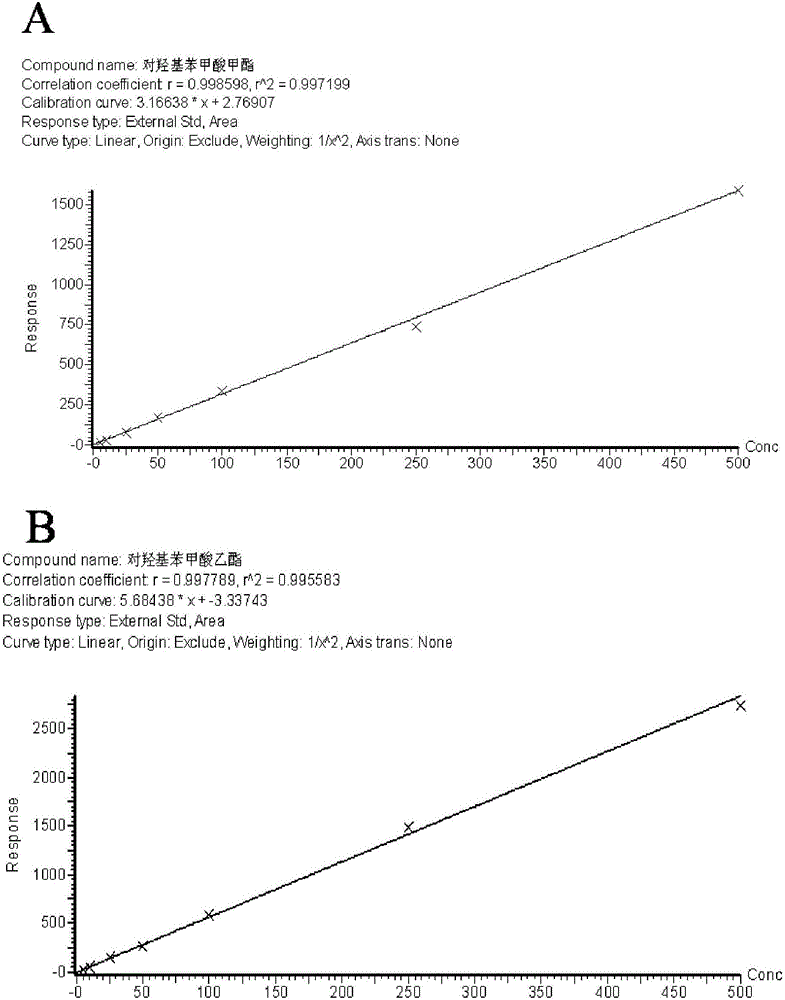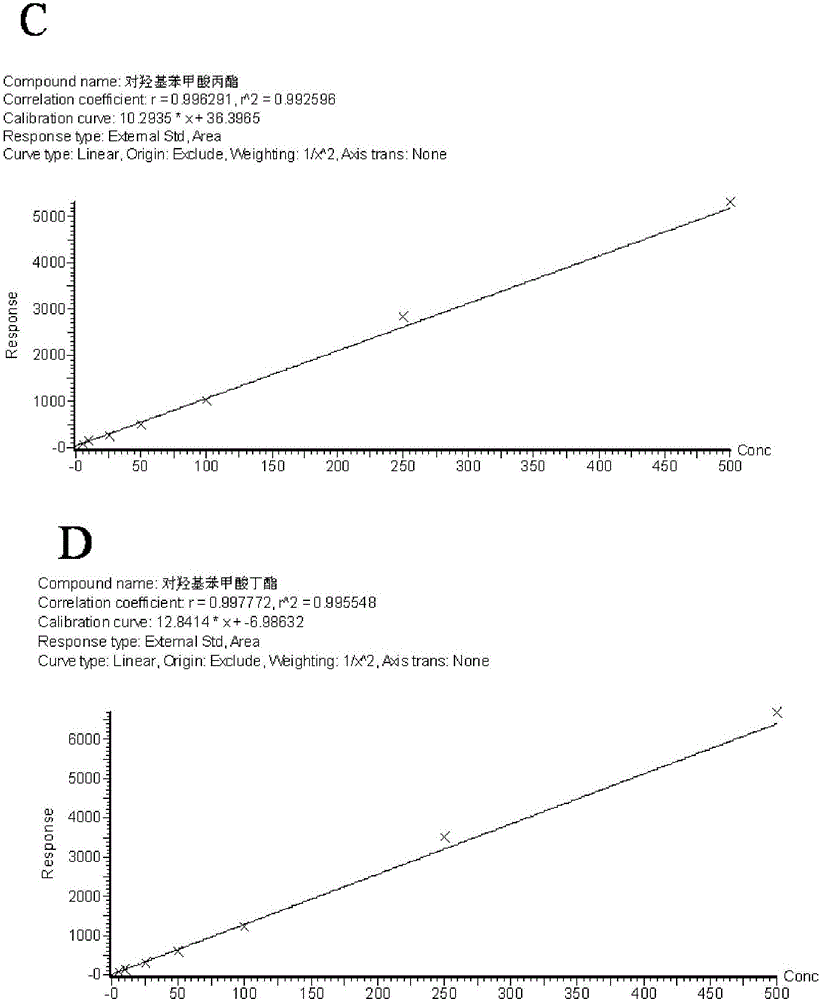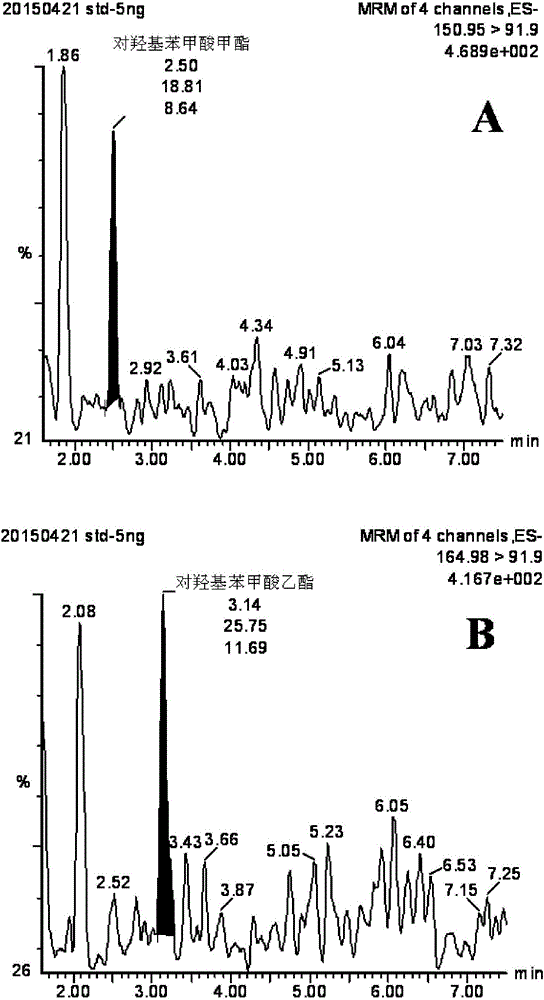UPLC-MS/MS detecting method for detecting concentration of parabens preservatives in human urine
A technology of p-hydroxybenzoic acid and propyl paraben, which is applied in the field of UPLC-MS/MS detection of the concentration of paraben preservatives in human urine, can solve the problems of large dosage, gastrointestinal discomfort, etc. Achieve the effect of high sensitivity and strong anti-interference ability
- Summary
- Abstract
- Description
- Claims
- Application Information
AI Technical Summary
Problems solved by technology
Method used
Image
Examples
Embodiment 1
[0035] Detection of the concentration of parabens in sample 1, sample 2, sample 3, sample 4, and sample 5 (the sample processing method and detection conditions are the same):
[0036] (1) Standard product treatment: Take 500uL of urine, add 50uL of standard solution, and prepare a series of solutions corresponding to the concentrations of plasticizer components in urine: 5, 10, 25, 50, 100, 250, 500ng / ml . Add 50uL of β-glucuronidase (80U / mL), shake well and seal, put in a 37°C water bath and heat for 120min. After the reaction, take 100uL of the reaction solution, add 300uL of precipitant (methanol / acetonitrile=1:1) to precipitate the protein, vortex and mix well, centrifuge at 15000rpm for 10min, and take 5uL of the supernatant for sample analysis.
[0037] (2) Standard curve creation: take the concentration of the analyte as the abscissa, and the difference between the peak area of the analyte and the peak area of the corresponding component of the urine sample as the...
Embodiment 2
[0052] 2.1 Method recovery experiment
[0053] Take six parts of the test solution, add equal volumes of 10, 100, 800ng / ml reference substance solutions of each component, mix well, prepare 5, 50, 400ng / ml reference substance solutions of each component, inject samples, and operate in parallel for each sample Six copies were used to calculate the recovery rate. The results are detailed in Table 5.
[0054] Table 5 recovery rate test result
[0055]
[0056]
[0057] 2.2 Method precision experiment
[0058] According to the QC sample preparation method, 5, 50, and 400 ng / ml solutions of each component were prepared, injected, and each sample was operated in parallel six times to investigate the precision of the method. The results are detailed in Table 6.
[0059] Table 6 method precision test results
[0060]
[0061]
[0062]
[0063] 2.3 Solution stability test
[0064] According to the QC sample preparation method, 5, 50, and 400 ng / ml component solutio...
Embodiment 3
[0069] The preparation and detection conditions of the lowest quantification limit (5ng / ml) concentration mixed standard and the mark line (25ng / ml) concentration mixed standard:
[0070] (1) Standard product treatment: Take 500uL of urine, add 50uL of standard solution, and prepare a series of solutions corresponding to the concentrations of plasticizer components in urine: 5, 10, 25, 50, 100, 250, 500ng / ml . Add 50uL of β-glucuronidase (80U / mL), shake well and seal, put in a 37°C water bath and heat for 120min. After the reaction, take 100uL of the reaction solution, add 300uL of precipitant (methanol / acetonitrile=1:1) to precipitate the protein, vortex and mix well, centrifuge at 15000rpm for 10min, and take 5uL of the supernatant for sample analysis.
[0071] (2) Standard curve creation: take the concentration of the analyte as the abscissa, and the difference between the peak area of the analyte and the peak area of the corresponding component of the urine sample as ...
PUM
| Property | Measurement | Unit |
|---|---|---|
| boiling point | aaaaa | aaaaa |
Abstract
Description
Claims
Application Information
 Login to View More
Login to View More - R&D
- Intellectual Property
- Life Sciences
- Materials
- Tech Scout
- Unparalleled Data Quality
- Higher Quality Content
- 60% Fewer Hallucinations
Browse by: Latest US Patents, China's latest patents, Technical Efficacy Thesaurus, Application Domain, Technology Topic, Popular Technical Reports.
© 2025 PatSnap. All rights reserved.Legal|Privacy policy|Modern Slavery Act Transparency Statement|Sitemap|About US| Contact US: help@patsnap.com



